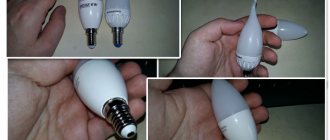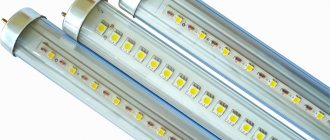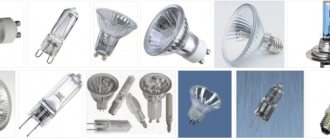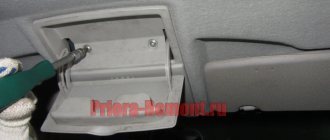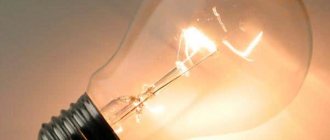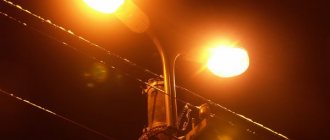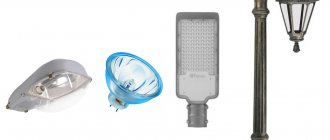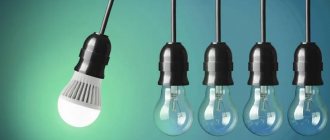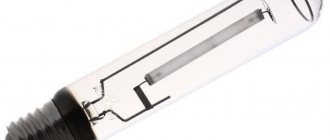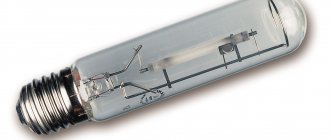Features of E27 and E14 sockets
Most often, screw and pin sockets are found on sale, differing in how the lamps are mounted.
The options discussed in the review belong to the same type. It is designated by the letter “E” (short for “Edison Screw type”) and is called Edison’s base, since it was he who patented this design at the beginning of the 20th century. Design of a standard incandescent lamp.
This variety is distinguished by the fact that the light bulbs are screwed into the socket using a special thread, which ensures reliable fixation of the light source. The main features are:
- Voltage is supplied through the central contact located at the end of the rear part. The cartridge has a spring element that is securely pressed against the surface and ensures current transmission with the minimum possible degree of heating.
- The neutral wire is connected to the side and fed to the threaded part. This system ensures the safety of the structure and prevents electric shock to a person when replacing a light bulb.
- Products are always made of metal. As for cartridges, they can be ceramic, carbolite and plastic. Each of the solutions has its pros and cons, but ceramics are considered the most reliable and last many times longer.
- The thread pitch is the same for both options. It is standard regardless of the type of structure and its diameter.
Both varieties are designed for voltages no higher than 250 V. Therefore, the main direction of their use is household lighting. These can be lamps of any type, decorative lighting or street lighting. But for outdoor use, lantern models with an increased degree of protection against moisture are selected.
Features and Specifications
E14 bulbs are the most common along with E27. Most types of miniature lamps are suitable for them, and the price of lamps varies from 10 to 20 rubles.
The devices are easy to use, do not cause difficulties when replacing the cartridge, and consumption is low. Designed to work with a voltage of 220 volts.
There are LED analogues that use the E14 socket. They are not very powerful, but the luminous flux is greater than that of incandescent sources. E14 diode lamps are compact, so they are also used for recessed luminaires.
Edison base
The Edison socket is a screw mechanism that was developed by Thomas Edison specifically for mounting incandescent lamps. Since then they have been produced with threaded bases of different diameters. In the designation, “e” means screw type, and the number is the diameter in mm. E14 is one of the most common household bases in Russia.
Design
Device
Structurally, the base is similar to a cylinder with a thread with a diameter of 14 mm. It is made of aluminum. There is a contact at the top. An electrode is attached to it, which leads to the filament body. The second electrode from the tungsten helix is attached to the thread of the base.
There is a hollow glass insulator inside. It is necessary for pumping out air and pumping inert gases and buffer mixtures into the flask. The insulator is present only in incandescent and halogen lamps. Other types have a similar base design.
It is important to connect the wires to the socket correctly. In the event of an error, there is a risk of electric shock to a person
To avoid this, the phase wire is connected to the base contact, and the neutral wire is connected to the screw thread.
Electrical connection
E14 sizes are standard.
Dimensions
Marking
For “Edison screw” type bases, the EXX marking is accepted, where:
- E – indicates the type (Edison Screw type);
- XX - numbers indicating the diameter, for example, the type of light bulb E14, indicates that the diameter of the base is 14 mm, that is, the difference between types E14 and E27 lies in the width of the socket.
Note that to ensure compatibility, special adapters are produced, for example, an adapter from E27 to E14 socket.
Thanks to such conductors, it becomes possible to install incandescent lamps of a standard size (E27) (as well as their energy-saving analogues) in a socket for a minion (E14).
The use of lamps with a minion base
Devices with an E14 socket are produced for the home, where they are used as sources of general or local lighting; in addition, such lamps can serve as backlight in various household appliances (for example, a lamp for a refrigerator).
Gradually, incandescent lamps are being replaced by energy-saving analogues; sources designed for use in minion-type cartridges are no exception. But when choosing them, it is necessary to take into account that the dimensions of energy-saving lamps are not so compact, so it may happen that they do not fit into the shades of some chandeliers or sconces.
The second factor limiting the use of energy-saving lighting sources for both E27 and E14 bases is their relatively high price. Currently, incandescent lamps are cheaper, but according to experts1, this situation will improve for the better in the near future.
It should be noted that thanks to the development of online trading, the cost of lamps is approximately the same in all cities of Russia, for example, in Moscow and Yekaterinburg the price is practically the same.
Characteristics of the base E27 (E14, E4)
A standard incandescent lamp with an E27 base is configured to operate at a voltage of 220 V. However, the latter indicator may have different values. These are 12, 24, 380 V, and in European countries it can be 110 V. Depending on the equipment, the requirements for power and the size of the contact part also differ.
Incandescent lamp e 27
Thus, in everyday life, cartridges for sockets e14, e27 and e40 are more often used. Their main characteristics are as follows:
| Criteria/Type | e14 | e27 | e40 |
| Marking | SES | ES | GES |
| Name | Small (minion) | Standard | Big |
| Voltage according to GOST | Up to 250 V | Up to 250 V | Up to 380 V |
The socket e14 is used in general-purpose lighting devices (sconces, chandeliers) and local ones. For example, in the refrigerator, oven or hood. Lamps with E27 socket are used to illuminate residential premises or streets. E40 is relevant for large workshops where high-power lighting is required.
In Russia, screw bases with other diameters are less common:
| Criteria/Type | e5 | e10 | e12 |
| Marking | LES | MES | CES |
| Name | Micro base | Miniature | Chandelier |
| Voltage according to GOST | Up to 24 V | Up to 250 V | Up to 250 V |
E5 cartridges can often be found in imported household appliances. Lamps with E10 socket can be found in decorative electrical appliances. For example, in garlands or slides. And E12 can more often be found in imported chandeliers or designer chandeliers with many bulbs.
Designer chandelier with E14 and E12 sockets
In America, the network voltage is often equal to 110 V. The diameter of the Edison base in their equipment is 17 or 26 mm. They are marked as IES (small) and ES or MES (inch), respectively.
You might be interested in Halogen lamps for lighting: main types
Types of sockets for LED lamps
Rezbovoy, E (Edison)
The most common type of holders. The letter E directly refers to the father of this light bulb - Thomas Edison. The threaded base is the most universal mounting method, not only because of its simplicity, but also because it operates on 220 V.
Standard LED bulb with E-27 threaded connector.
Known models of LED lamps with type E connector:
- E5;
- E10;
- E12;
- E14 (minion);
- E17;
- E27;
- E40.
Find out also: What is the difference between E14 and E27 sockets.
Pin, G
LED lamps with connectors marked with the letter G are no less in demand.
Such holders are visually similar to a fork.
The most commonly used models are:
- GU3 (for 220 V or 12 V network);
- G4 (12 V or 24 V);
- GU10 (swivel base);
- G9 (for decorative LED lamps);
- G13;
- G23;
- GX53 – a light bulb with a screw-on holder, used for installation in suspended, suspended, or plasterboard ceilings;
- GX70 – differs from GX53 only in the distance between the pins.
Telephone, T
This type of LED light bulbs is not used in everyday life. Areas of application – electronics and industry:
- control panels;
- automatic shields;
- power plants.
The bulbs have an oblong appearance and resemble a flask.
The number after the letter T in the marking shows the external width, which is measured using the contact plates.
Pin, V
This type of holder is essentially an improved version of Edison's threaded sockets. It was designed for smaller types of lamps, which, if necessary, can be quickly replaced. The LED pin base is distinguished by round pins located on the sides. Using these parts, the holder is inserted into the cartridge.
One of the pins is clearly visible here.
There is also a BA model with asymmetrically located pins. Such lighting devices are used in car headlights, lights on ships, and trains.
Holder with recessed contact, R
R-type sockets are rarely used in LED lighting. These holders are more common for halogen and quartz bulbs. Most often, connectors with recessed contacts are used in small, lightweight luminaires that are part of high-intensity lighting systems. A simple example of such an installation is street floodlights.
The most famous model of the holder with recessed contact is R7s. On the marking, after these symbols, the numbers 78 or 118 are indicated. This is the total length of the lamp in millimeters.
Sofitny, S
Soffit holders are marked with the capital letter S. They are equipped with contacts on both sides
Car enthusiasts, of course, know the importance of lamps with soffit bases for illuminating license plates. In addition, S-bases are used to illuminate mirrors, bathrooms, as well as stages in theaters and concert halls.
The number after the letter S indicates the diameter of the housing.
Typical soffit base.
Focusing, R
The main task of this type of base is contained in the name itself. Film projectors, spotlights: all these lighting devices cannot be imagined without lamps with focusing holders. The main nuance of the design of such connections is a special lens. It collects and then scatters the light flux in the desired direction. The number in the marking indicates the diameter of the holder body.
How to disassemble an e40 LED lamp
As mentioned above, led e40 differs from e27 mainly in size. Therefore, disassembling such a lamp is no more difficult than the usual E27.
LED design
First you need to remove the diffuser. If it is not glued with sealant, then simply carefully twist it and remove it.
If the diffuser has latches, then use a sharp knife or awl to carefully move around the circumference of the joint until you hit the latch. After this, use a knife to carefully bend the latch and remove the diffuser
If the diffuser is glued with sealant, you will need a solvent (not acetone!), an awl and a syringe with a needle. The awl needs to be drawn over the place where the diffuser is attached.
Then carefully pour the solvent drop by drop from the syringe into the remaining well. Wait five minutes: the solvent will soften the sealant
Then carefully rotate the diffuser and remove it.
After removing the diffuser, you need to remove the board with the LEDs and take out the driver. If the board has screws, use a screwdriver to unscrew them. If it is glued with sealant, then cut around the circumference with a sharp knife and remove the board by prying it off with a knife.
Schematic diagrams of LED lamps
The reliability of LED lamps depends on the quality of the parts and their assembly. The most important component is the driver.
In its simplest form, it consists of a capacitor and a voltage rectifier. A resistor is used as a current limiter. The circuit is elementary, contains a strictly defined number of LEDs. This lamp can be easily repaired at home. But the light from such a source is pulsating and has a short service life.
Electrical circuit of a simple driver
A more complex driver version contains:
- a bridge voltage rectifier, which limits the input current through a capacitive balance;
- several capacitors;
- system for regulating current and voltage parameters;
- coupling circuit for dimming (not available for all models).
Driver circuit diagram
Moreover, the “goliath” for a “complex” driver plays a positive role: in a large lamp, all the above-described components are located without problems. (The same cannot be said about small LED light sources).
The driver of a complex design helps to shine with even light and work for a long time. However, such products cost more and are difficult to repair.
There are many intermediate electrical circuits. The design should be chosen based on the purpose of the light source: for night illumination of deserted spaces, a light source with a simple driver is sufficient.
Advantages and disadvantages of E27 and E14 sockets
Each option has pros and cons that should be considered when choosing a chandelier or other lighting equipment. The main advantages are:
- The E27 base is most common in our country. This type of light bulb can be purchased at any hardware store and many grocery stores. This option is available even in the most remote villages; it is easy to use and safe. And the price for such products is the lowest of all.
- Option E14 is found in most modern lamps manufactured abroad. It is not so common here, but it has one big advantage. You can buy an adapter and then a light bulb with an E14 socket can be screwed into an E27 socket, which is very convenient.
A light bulb with an E27 base can be found almost everywhere.
Among the disadvantages, it is worth highlighting that both varieties can stick to the socket when overheated and replacing the light bulb will cause great difficulties. Over time, the central contact loses its elasticity and needs to be bent for reliable clamping.
What common
Both lamp models we are considering, despite the different type of base, have several common features. For example, both E27 and E14 can be used for installation in lighting fixtures to illuminate equipment in residential, commercial and industrial premises. Products with these indices on the socket, as a rule, consume less energy compared to incandescent lamps, and are also low in cost.
Reference! Using a special adapter, you can install E27 in a cartridge with a thread for E14.
Areas of application
The human eye responds best to sunlight. Therefore, the closer the light emitted by an electric lamp is to natural, the more comfortable we feel during a long working day. It is the LED E14 lamp, thanks to its soft light, that can significantly reduce eye strain and thereby protect a person from rapid fatigue.
Creation of general lighting in residential premises, organization of complex industrial, emergency, street lighting, use as obstruction lights, creation of various types of lighting - in all these areas it is possible to effectively use energy-saving LED lamps E14.
Today, E14 LED lamps, the price of which ranges from 100 to 150 rubles, are available to the majority of consumers. Such lamps are installed in almost all major retail chains, public and entertainment establishments. Entrepreneurs understand that it is more profitable to install LED lighting at an affordable cost than to once again burden themselves with constant maintenance and replacement of standard incandescent lamps.
What to consider when choosing an e14 lamp
When choosing a light bulb for a lamp, you need to consider the following important parameters:
- power;
- sizes, shape;
- company manufacturer;
- optimal mains voltage.
When purchasing the product, you should inspect the integrity of the product. If scratches or unreliable contacts are found, such a light bulb cannot be taken.
When choosing an LED device, you need to pay attention to:
- Glow efficiency. This parameter shows how much luminous flux the light bulb produces per 1 watt. The efficiency of diode products ranges from 60 to 80 lm/W.
- Glow power. It can be compared with the indicator of an incandescent lamp using special tables.
- Colorful temperature. The shade of the glow depends on it. It is selected depending on the purpose - for example, when used in a residential area, it is better to give preference to warm colors. For offices, light bulbs are purchased in neutral white shades. Cool colors can be used in industrial areas. Color temperature is measured in Kelvin (K). Warm white shades are in the range of 2700-3500 K, neutral – 3500-4000 K, cold – 5500-6000 K.
- Mains voltage. LED devices operate either from a 220 V network or from a 12 V power source. Devices with socket e14 and e27 can operate on direct and alternating voltage.
- Color rendering index. Measured in the range from 0 to 100. High-quality display of the color gamut is available with an index of 98 and higher. Below 80, color distortion occurs.
- Direction of light, angle of illumination. Depending on the shape, the radiation pattern and, accordingly, the direction of illumination differ.
- Ability to control brightness. This is an additional feature; these lamps have dimmers that allow you to change the brightness.
- Ripple factor. Flickering light negatively affects the eyes and nervous system, so for health safety you should buy products with low pulsation. SNIP recommends purchasing devices with a coefficient of 5-20%. Flickering lamps are usually produced by little-known companies that sell products at low prices.
- Date of manufacture. Models older than two years may be significantly inferior to the latest products in terms of their characteristics.
- Warranty, service life.
Results
The test results confirm the declared parameters of Remez E14 and E27 LED lamps. Samples with a temperature of 5700K provide a luminous flux higher than promised by 30-50%. High-quality assembly and low heating will maximize service life; the manufacturer provides a 5-year warranty. The high quality power supply (driver) guarantees stable operation even at a voltage of 90 Volts without reducing brightness. The cost depends on expensive Korean Sunlike LEDs, due to which the light is safe and unique.
Types of lamps with e27 base
Incandescent lamp
Historically, the first developed version of light sources. E27 was developed specifically for this type, so other types of bases are rarely used in their design. The power is in the range of 15-250 W, the luminous flux is the smallest - approximately 10 lm/W.
The advantages include low price, simplicity and reliability of design, stable glow in difficult operating conditions: high humidity, low temperatures. Good quality of light: smooth, not pulsating.
On the other hand, incandescent lamps have little service life and consume the maximum amount of energy. Because of the glass bulb, they are very fragile and become very hot when illuminated.
Energy saving
Compact fluorescent lamps (CFLs) have replaced incandescent lamps. CFLs differ from ordinary direct fluorescent lamps in their shape: the tube with mercury vapor is rolled into a spiral to reduce overall dimensions. High luminous flux: 50-70 lm/W.
The advantages of fluorescent light sources include low electricity consumption and a long service life.
Among the disadvantages, there is a danger to human health due to the presence of mercury vapor; need for special disposal. To operate at the rated power level, it takes some time to warm up. CFLs do not work well at low temperatures (less than +5⁰); Below -15⁰ they are not allowed to be used at all. The quality of their glow depends on the stability of the network voltage and the number of on-off cycles. High price.
Halogen
They are designed like incandescent lamps, only halogen vapors are added to the bulb. This leads to an increase in operating time and light output: 17-20 lm/W. E27 is not the most common type for halogens. Type g is most often used.
Among the advantages of the light source, one can note the ability to glow in difficult operating conditions: at low temperatures, high humidity. Low price, good quality light.
The disadvantages include the dependence of operation on the stability of the voltage in the network, high energy consumption and operating features: it is forbidden to touch the halogen lamps with hands without gloves - this causes rapid failure due to fingerprints on the bulb.
LED
The youngest type of light sources. They are characterized by the highest light output (80-120 lm/W) and the longest operating period. LED lamps with E27 are designed to replace incandescent lamps.
Among the advantages are a stable glow under difficult operating conditions, a wide range of color temperatures, the ability to work with a damaged bulb, and high energy efficiency. Some models have dimming capabilities.
The disadvantages of LED lamps include high price and dependence on the stability of the mains voltage. Low voltage models (12, 24 V) require additional equipment. Also, due to the degradation of LEDs, the brightness decreases towards the end of their service life.
Comparative characteristics of all types of light sources are given in the table. (For comparison, lamps with an equal luminous flux of 1200 lm were used).
| Comparison parameter | Light source type | |||
| Incandescent lamp | "Halogen" | CFL | LED | |
| Power, W | 100 | 50-70 | 25-30 | 12-15 |
| Service life•, h | 1000 | 2000-4000 | 10000-15000 | 20000-50000 |
| Color temperature, K | 2400-3000 | 2700-3000 | 2700-6000 | 2800-6500 |
| Price | Low | Average | Above average | High |
| Disposal | Regular | Separate from ordinary glass | Only at special collection points | Regular |
| Environmental Safety | Safe | Safe | Very dangerous | Safe |
| Electricity consumption | Maximum | High | Small | Minimum |
| Dependence of operation on voltage drops | Eat | Eat | Eat | Eat |
| Low temperature dependence | Absent | Absent | Present | Absent |
| Dependence on high humidity | Absent | Absent | Present | Absent |
— the service life declared by the manufacturer is given when operating under ideal conditions.
For what types of lamps is the E27 socket suitable?
Lighting equipment differs not only in cartridges. Technical characteristics are important: voltage, power and permissible temperature values. In accordance with this information, certain lamps are selected.
The only problem that can be easily solved is the diameter of the screw base. Manufacturers offer a variety of adapters to choose from. True, then the socket will be lengthened, and the light bulb will stand out more from the shade. But everything will work properly.
Adapter from E14 to E27
If you make a mistake in choosing the type of lamp, you can make a mistake with the heating and the cartridge will begin to melt. Incorrect voltage will lead to failure of any device.
Incandescent lamp
The classic type of lamps with a tungsten or carbon filament inside occupies a leading position in popularity. The main reason for this is the low price. The technical specifications are as follows:
- luminous flux about 9-19 Lm/W;
- power from 25 to 150 W;
- voltage can be 230 and 380V;
- durability is approximately 1000 hours;
- yellow color.
You may be interested in Various staircase lighting systems
The lamp turned black over time
However, in the modern market, incandescent lamps are noticeably inferior to other analogues.
Important! The threads heat up to 2-3 thousand degrees Celsius, which is why plastic cartridges often melt from heating. During operation, vapors are generated inside the flask, which leads to clouding of the glass. As a result, the level of illumination decreases.
In the group of incandescent lamps, there are several separate types. Reflector devices with internal silver coating are used when directional light is needed. To create a bright environment, use illumination lamps coated inside or outside the bulb with inorganic pigments. It is worth noting that the power can reach only 10-25 W.
Pigmented lamps
For designer lighting, manufacturers offer to install decorative products. It is distinguished by the shape of a transparent flask and large spirals of threads inside.
Halogen
This type of lamp is improved by the presence of halogen vapor in a vacuum of a smaller bulb. At the same time, the power is increased by 2 times. Tungsten filament lasts from 2000 to 5000 hours. In this case, the luminous flux has an indicator of 17-20 Lm/W. Products that are supplemented with bromine or iodine illuminate approximately 10 Lm/W stronger. The operating voltage can be either 220V or 12V.
Energy saving
Fluorescent lamps consume 5 times less energy than conventional lamps. That is, emitting daylight (white) or yellow light with a power of 25 to 600 W will take 5 and 120 W, respectively. The luminous flux is 44-70 Lm/W.
Energy saving lamp e27
The service life is 1000-15000 hours. But there is an opinion that frequent connection and breakage of contacts leads to a reduction in these indicators. During the glow, ultraviolet radiation is released, which sometimes negatively affects human health.
The features of energy-saving lamps include 2 points. The first is to set the color. This takes from 3 to 120 seconds. The second nuance is flicker. If this happens, it means the device will soon fail. Application has restrictions regarding temperature. Light bulbs should not be used at temperatures below −15 degrees Celsius.
Important! It is worth noting the presence of phosphorus and mercury. If the flask breaks, the room should be ventilated immediately and the fragments should be removed immediately.
You might be interested in this Features of DRV lamps
Broken energy saving lamp
LED
These lamps began to actively displace other analogues for decent energy savings. When consuming 4-15 W, the device shines at 30-150 W. In this case, the luminous flux is 80-120 Lm/W, and there is practically no heating of the housing. Such lamps operate under voltage of 12, 24, 220 V. They last from 15,000 to 50,000 hours.
Unlike other options, some LED fixtures are approved for use with dimmers. A special circuit is built inside the case that senses the signals supplied by the device. Manufacturers indicate this on the packaging.
The most common forms of "minions"
The appearance of the lamp when installed in an outdoor fixture can be very important. An incorrectly chosen shape will ruin the interior even with the most beautiful chandelier. The most versatile lamp with an E14 base is the “candle”, used in ceiling chandeliers. For a sconce or night light, a good choice would be to purchase shapes such as “candle in the wind.” It differs from the previous version with an elongated “tail” and a slightly curved top of the flask. The third common form of such emitters is the “twisted candle”. Its bulb has pronounced spiral structural stripes.
A slightly less popular form due to its higher cost can be called “fire flame”. The use of such emitters in lamps with a shade is irrational - the bulb must be completely visible in order for the effect intended by the manufacturer to be realized.
For ordinary closed lamps, the cheapest shape options are used - “pear”, “elongated ball”, “ellipsoid”. For household appliances (refrigerators, microwave ovens, ovens), lamps narrowed to the base are used, and for spotlights, a “parabolic reflector” is suitable. In total there are 13 main forms.
What types of lamps are there with this type of base and where are they used: features and parameters
E14 socket is used in incandescent, fluorescent, halogen and LED lamps. All of them are used in lighting fixtures, to illuminate refrigerators or microwave ovens. Bulbs of different types of E14 base will differ in size - products with one filament are the smallest. Therefore, when buying household appliances, you should understand that they will look different in a chandelier.
There are also differences in the shape of the E14. The most common type of light bulb is a candle, which is used in ceiling chandeliers. The applique contains products in the shape of a “Candle in the Wind”: the upper part of the light bulb is slightly elongated and curved.
Flame bulbs are the most expensive and least popular type of light bulb. According to the manufacturer, the light bulb should be visible, so there is no point in using it in lamps with a lampshade.
Closed light sources use classic shapes: “pear”, “ellipsoid”, “ball”. Appliances with a narrow base are installed in ovens and refrigerators.
Important! In total, there are 13 main forms of E14 bases.
Useful recommendations for choosing
To summarize the review, we can highlight several points that will greatly facilitate the selection of a suitable LED light bulb model with a standard base.
Firstly, the type of socket installed in the lighting equipment must correspond to the size of the base of the lamp being purchased. For sockets E 14 and 27 there are special adapters.
Secondly, additional savings on purchases are not always advisable. Cheap light bulbs sold by unreliable brands often fail. Trusted manufacturers are responsible for the quality of the product and guarantee replacement or repair of the product in case of breakdowns.
Lighting equipment equipped with a matte bulb is ideal for organizing softer and more subdued lighting in a room that does not irritate the eyes. If the room requires a bright light source, it is more advisable to buy LED lamps with a transparent bulb
Thirdly, light sources with filament or fluorescent light bulbs must be correctly replaced with LEDs, selecting a similar luminous flux power. In this case, you can refer to the table above.
Before purchasing, you need to check whether the light bulb is pulsating during operation. Having discovered such a phenomenon, it is advisable to discard the device, since its control circuit is imperfect.
Chuck device
In most cases, the e14 electric cartridge is attached to the lamp using the bottom. There is a hole for the cable. There are models with pin fastening to the lamp, classic screwing and combined fastening (when the light bulb is placed in part of the socket and then screwed in). It is interesting to note that elements with a rotary-threaded connection are complex, but irreplaceable, since they are constantly subject to physical and mechanical stress.
You may be interested in this Features of smart light bulbs
Today, you can attach the base to the lighting equipment by the conductive wires, using a tube, contact clamps and a sleeve.
For current-carrying wires
A plastic sleeve is placed at the bottom of the E14, which has a central hole for the cable. Next, the plastic screw is installed, the base is connected and the wires are clamped with the screw. As a result, the base is securely fixed.
Device for current-carrying wires
On the phone
The base on the tube is attached thanks to nuts, with the help of which the fittings for the chandelier with caps are installed. The entire load falls on the tube. Wires for lighting pass through it. The threaded sockets can then be decorated with lampshade rings or other decorative elements.
Device on the tube
Bushing
Bushing is a device for securing sockets in light bulbs with wall sconces. It is made from sheet materials. A hole is made to attach the E14 base
It is important to note that plastic bushings are not used, since the light sources in them are deformed. Metal models should be used
Mounting threads vary, so there are no standards.
Note! To replace the plastic sleeve, you should use a resistor. Before breaking, you should disassemble and compare the threads
Bushing device
With screwless terminals
The cartridge case with the e14 bottom, which uses screwless types of clamping contacts, is connected by latches. The bottom is screwed onto the threaded tube and then the electrical wires are made. The body is created in the form of a cylinder and attached to part of the bottom. E14 elements can be repaired and serviced independently at any time.
Device with screwless terminals
The e14 electric socket is the most common lighting fixture socket. It has a low price, ease of operation and a wide color range. It does not heat up and does not contain harmful substances.
Marking
The marking designation of fluorescent lamps is indicated on the box and contains information about the company, power, base design, period of operation, shade of glow, etc.
According to the decoding of the index, the first letter of the marking of luminescent type devices is L. Subsequent letters indicate the color of the device’s radiation shade (daylight, white, cool white tone, ultraviolet radiation, etc.). The code value will include the characters D, B, UV, etc.
Design features on the markings are indicated by the corresponding letters:
- u-shaped fluorescent lamps (U);
- ring-shaped products (K);
- reflex type devices (R);
- quick start lamps (B).
In luminescent devices, the luminescence indicators are also displayed on the marking; the unit of measurement is Kelvin (K). The temperature indicator of 2700 K corresponds in hue to the radiation of an incandescent lamp. The 6500 K marking indicates a cold, snow-white tone.
The power of devices is marked with a number and unit of measurement - W. Standard indicators are represented by devices from 18 to 80 W.
The label also identifies the lamps according to characteristics such as length, diameter and bulb shape.
The diameter of the bulb on the lamp is fixed by the letter “T” with a code designation. The device designated by code T8 has a diameter of 26 mm, T12 - 38 mm, etc.
Markings of devices by base type contain the letters E, G and a digital code. The designation for the miniature form of the threaded base is E14. The middle threaded base has code E27. The plug-in base for decorative structures and chandeliers is marked with the G9 symbol. U-shaped devices are designated by the symbol G23, double u-shaped devices by G24, etc.
The color temperature of the devices varies depending on the model, ranging from 2000 to 6500 K. The efficiency of the lamp is 45-75%.
How to choose an E14 lamp
There are quite a lot of light bulbs on the market with the E14 base type. To choose the right option, you need to consider:
- Power. In addition to traditional measurements, many manufacturers also indicate the area for which the light bulb is designed.
- Dimensions, shape. Not only practicality, but also cost and decorative components depend on them.
- Manufacturing company. It is better to trust well-known companies whose products have a reputation for reliability.
- Network voltage requirements. If the home's network does not match the parameters of the light bulb, it will have a bad effect on its efficiency and durability.
- Integrity. Before purchasing, be sure to remove the product from the box and inspect it for scratches, chips, or other damage.
Types of lamps with E27 base, their features
Lamps differ in operating principle and performance characteristics. Each type is also presented under the E27 label.
Incandescent lamps
The device of a standard incandescent light bulb.
The oldest version of lighting lamps, it was for them that the E27 base was developed, so this size is most often installed in incandescent lamps. As for the technical characteristics, the power ranges from 15 to 250 W, and the luminous flux is about 10 Lm/W.
Advantages:
- low price;
- even light;
- not afraid of moisture;
- simple design.
Minuses:
- high energy consumption;
- short service life;
- fragility of the flask;
- heat.
Read more about the characteristics and types of incandescent lamps here.
Halogen
Halogen lamp device.
The operating principle is similar to incandescent lamps, but additionally halogen vapors enter the bulb. This increases the luminous flux, which reaches 17-20 Lm/W. For halogen models, a base marked G is more often used.
Advantages:
- work at different temperatures;
- not afraid of moisture;
- good and uniform light;
- price.
Flaws:
- requirements for stable voltage;
- high power consumption;
- You can only touch them with gloves.
Energy saving
Types of compact fluorescent lamps.
These are fluorescent lamps that differ in design. They are usually made in a spiral shape, along which mercury vapor moves. It has a high level of luminous flux - up to 70 Lm/W.
Pros:
- life time;
- economical electricity consumption;
- bright light.
Minuses:
- special disposal requirements;
- works with mercury vapor;
- After switching on, they warm up for a while;
- do not work well at low temperatures;
- high price.
E27 base design for light bulbs
At the bottom of the Edison base there are diodes that receive the signal from the cartridge. From them the current passes through two wires. Black is connected to the body, red is connected to the central pin. From them electricity is already supplied to the final destination.
In incandescent lamps, a plug is also built into the base. This is a special tube through which air is pumped out of the flask during production or inert gases and halogen vapors are added.
LED lamps and dimmer
Cartridges with threads of any diameter are installed in lighting devices with a power from 3 to 1000 W. Edison's invention has become widespread due to the fact that modern technologies make it possible to connect not only bulbs with an incandescent filament to the base, but also various options for energy-saving analogues. Easy to manufacture, the lightweight aluminum body is practically not deformed and lasts a long time, which is also the reason for its great demand.
